Briefly: In our opinion, full (150% of the regular full position) speculative short positions in gold, silver and mining stocks are justified from the risk/reward perspective at the moment of publishing this alert.
Yesterday’s session was quite average if one focuses on the performance of gold and the mining stocks, but it was far from being average in case of silver. The white metal soared almost 3% erasing several days of declines in one take. What are the implications?
The (surprising, for those who have not been following our analyses for some time and unsurprising, for those who have) implication is that the short-term outlook became even more bearish than it was. Yes, silver moved higher on high volume and by following the technical analysis principles to the letter would give us very bullish outlook, but after analyzing the silver market daily for more than a decade, we know that the analysis of silver should be anything but classical. The white metal has its own set of rules that often contradict the classic ones. The short-term strength – especially the one confirmed by strong volume – is actually a bearish sign if it is not confirmed by gold and – in particular – mining stocks. Well, was it confirmed? Let’s take a look at the chart for details (chart courtesy of http://stockcharts.com).
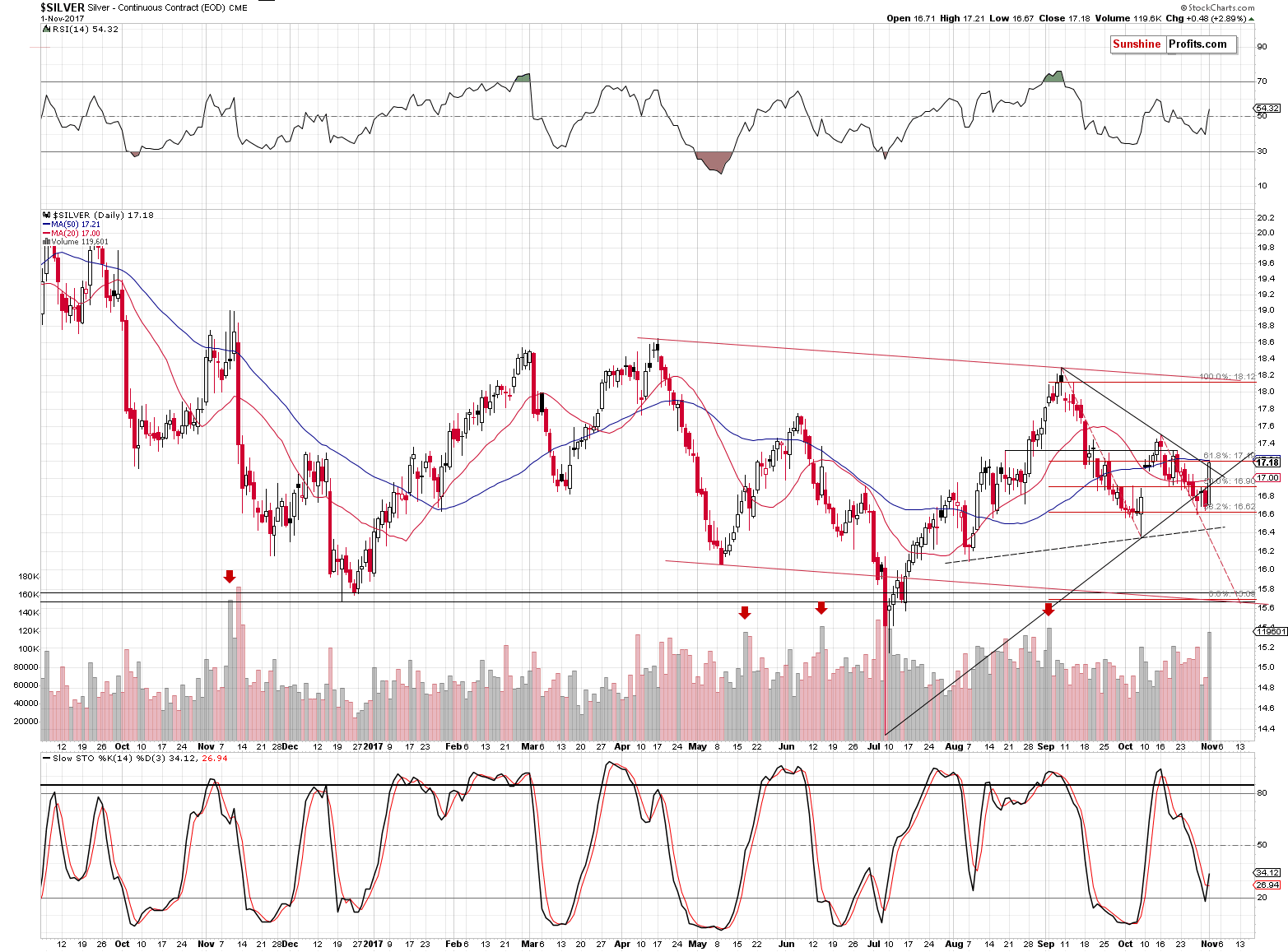
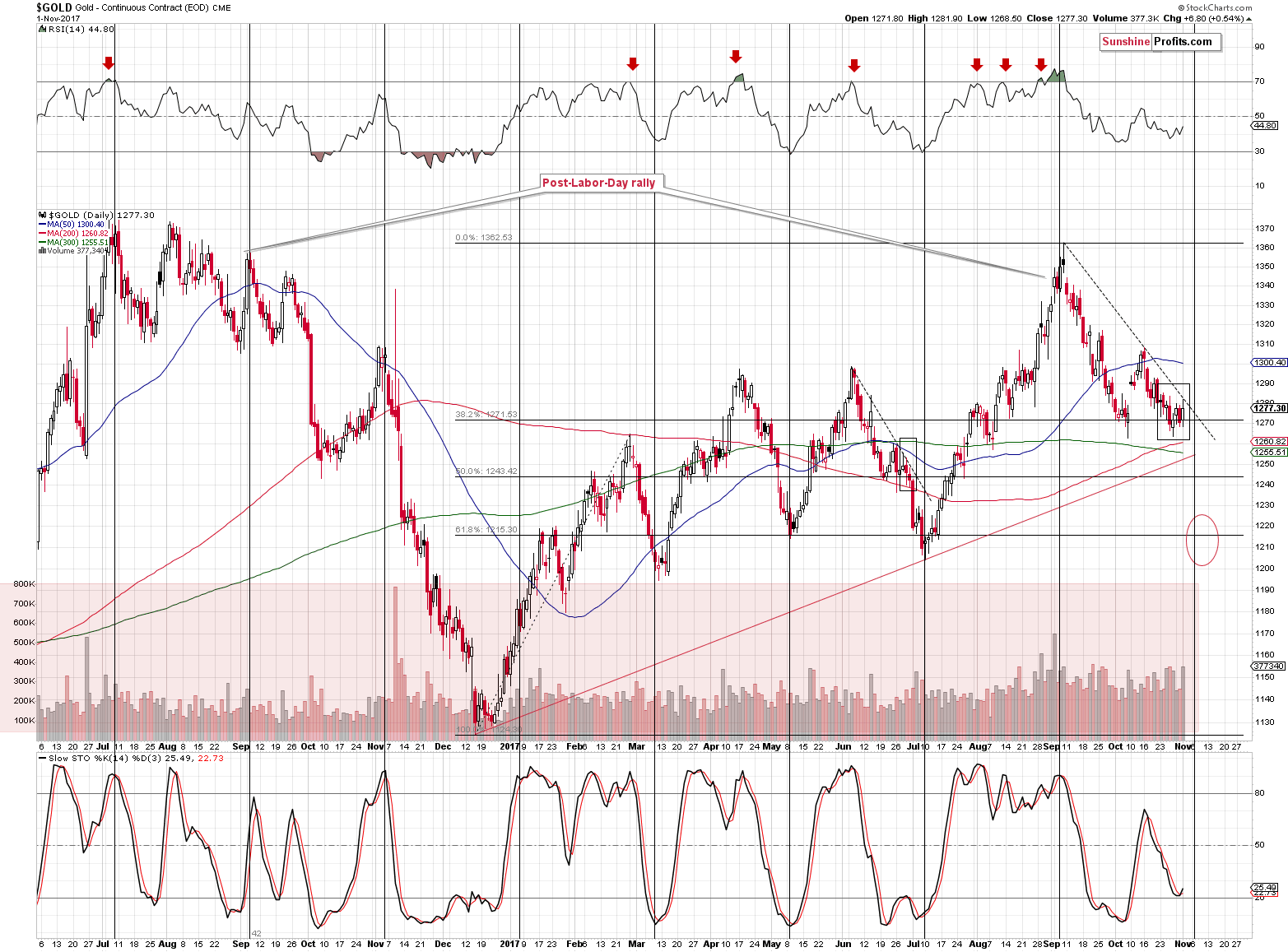
Silver soared, but gold was higher only insignificantly. Moreover, gold’s move higher was in tune with what we wrote previously:
Gold moved higher on relatively low volume, which is a classic indication that what we’re seeing is a pause. If gold is not done correcting, it seems that it will not move visibly above $1,285 (declining, short-term resistance line), so the upside is very limited.
Since we wrote the above, the declining short-term resistance line moved lower and it was more or less at $1,282 yesterday, which was gold’s intraday high. The trend remains clearly down.
Moreover, please note that this kind of performance was seen in June before the slide below $1,220 – please compare the situations marked with black rectangles. In both cases gold declined significantly after the initial top then corrected a part of the decline, moved to the previous low and then rallied back up to the declining short-term resistance line. That was almost right before the sharpest part of the decline. The implications for the following days are definitely bearish.
Speaking of bearish implications, mining stocks continue to provide them as well.
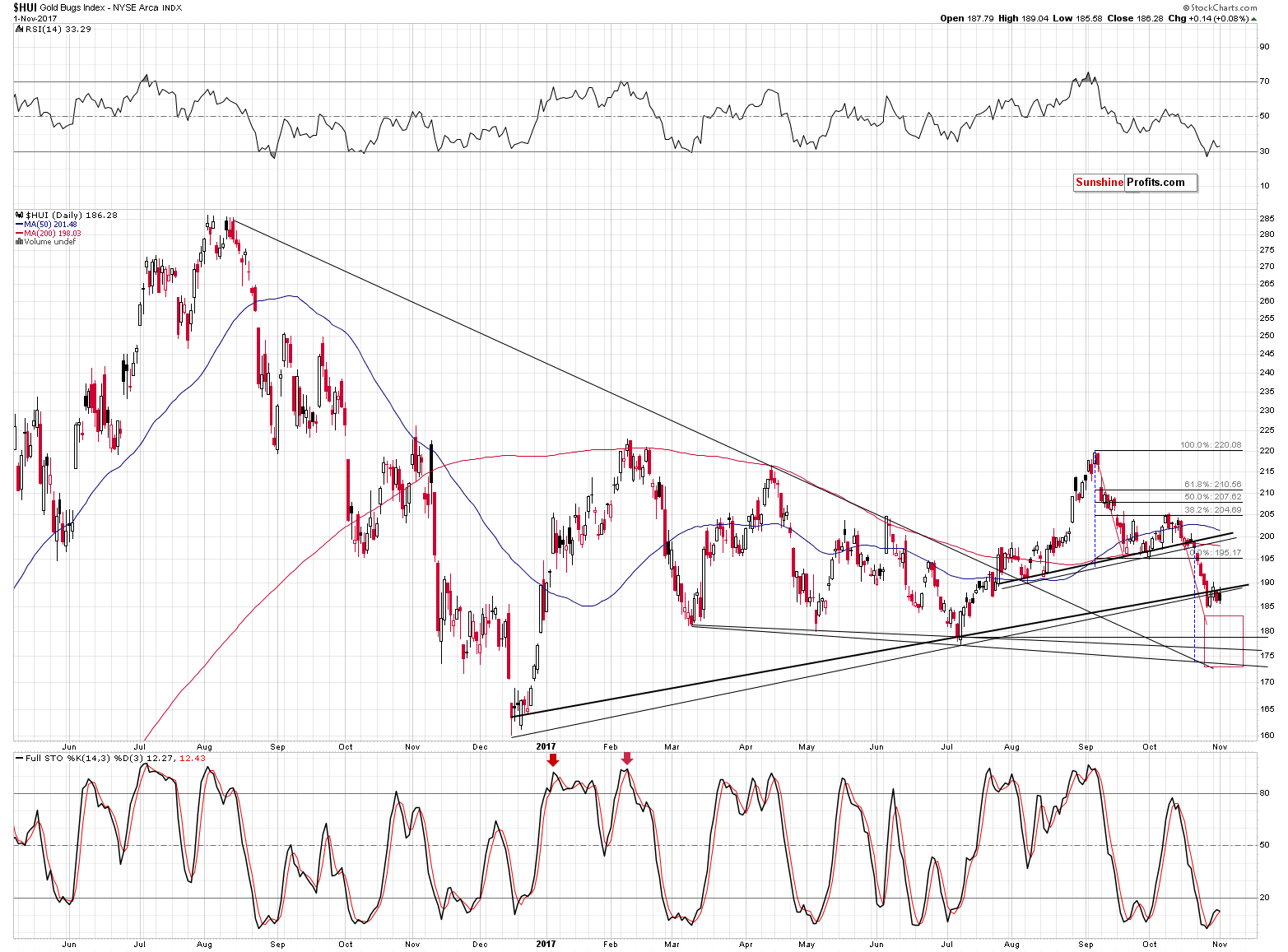
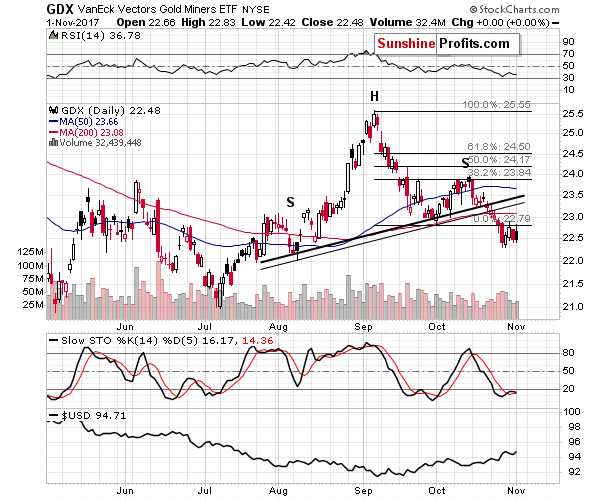
The HUI Index confirmed the breakdown below the rising medium-term support/resistance lines and the GDX ETF confirmed the breakdown below the early October low.
Moreover, GDX was flat yesterday and gold stocks were up only very insignificantly. That’s not a confirmation of silver’s supposedly bullish rally – that’s a clear sign that silver’s rally was fake. The implications are very bearish.
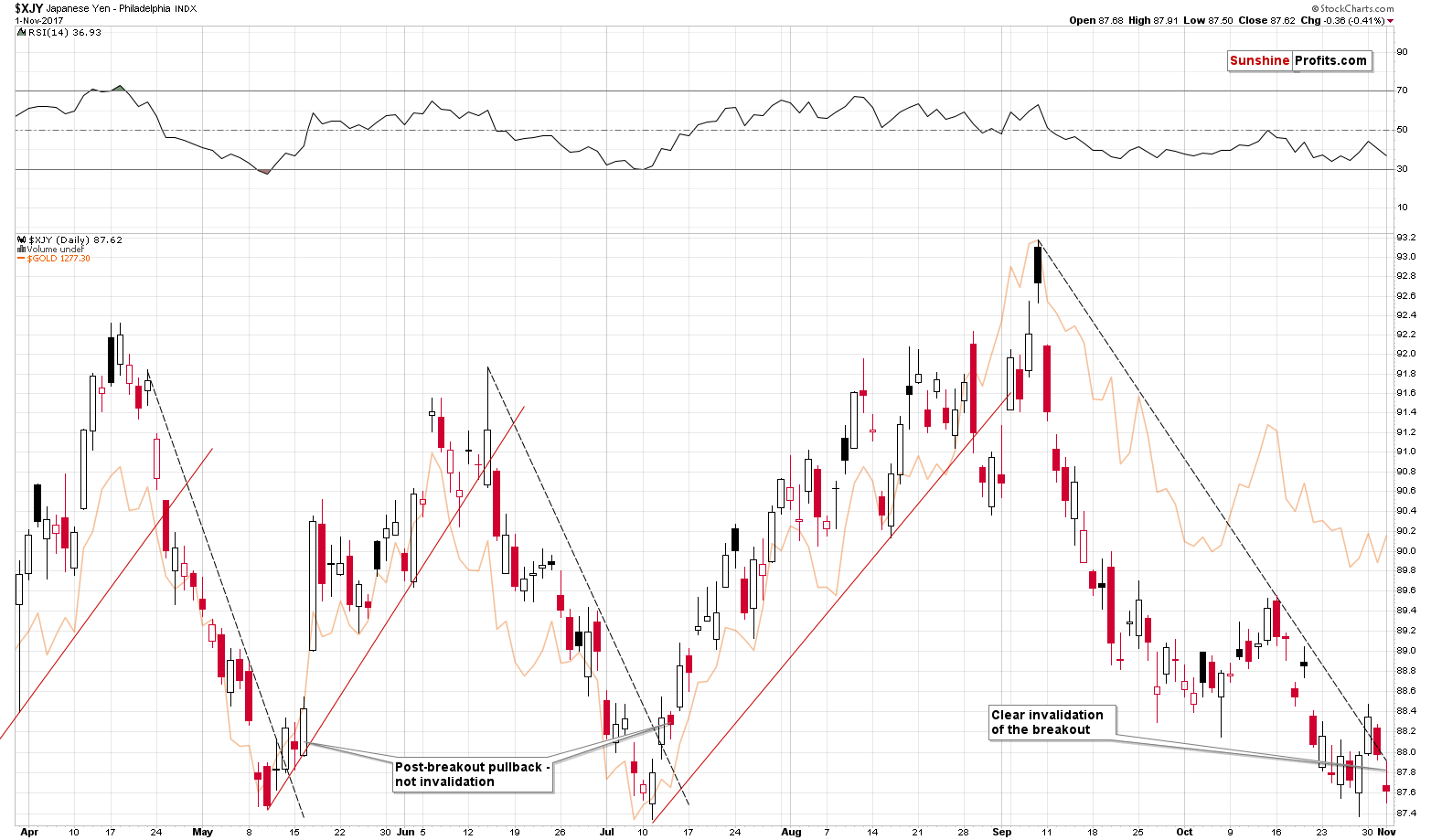
The situation on the Japanese yen chart is also very interesting. The Japanese currency moved to its May and July extremes and consequently it should be likely that we’ll see another reversal. But that is not the case as this time the situation is developing differently.
While in the previous 2 cases when the yen was at the current levels we saw breakouts and only tiny pauses shortly thereafter, this time we saw a breakout that was followed by its invalidation. Consequently, this time, the situation really IS different and the follow-up action could be different as well. Namely, we could see a breakdown in the yen and a slide in gold which tends to move in tune with the former.
Summing up, silver’s strength along with mining stocks’ is not a bullish combination, but a classic pre-decline confirmation. The implications are bearish, especially that the analogy to the 2012-2013 decline remains in place and the previously discussed long-term signals remain in place: gold’s huge monthly volume, the analogy in the HUI Index, the analogy between the two most recent series of interest rate hikes, and the RSI signal from gold priced in the Japanese yen.
As far as the following weeks are concerned, it seems that we could see another rebound during the decline, but not likely until gold moves to the $1,200 - $1,220 range, which is likely to take place in the first half of November (likely at the end of this week or in the first part of the next week). The analogous range for the USD Index is 95.5 – 96.5 with the 96 level being the most likely target.
We understand that it may not seem believable that gold could decline in the near future or that the decline is going to be really huge, but please keep in mind that this is the generally the case with big moves (and the same was the case with the 2013 slide) – they don’t appear believable until they are over and it’s too late to take action at that time. We will continue to monitor the market and strive to keep you informed and prepared for what’s coming.
As always, we will keep you – our subscribers – informed.
To summarize:
Trading capital (supplementary part of the portfolio; our opinion): Short positions (150% of the full position) in gold, silver and mining stocks are justified from the risk/reward perspective with the following stop-loss orders and exit price levels / profit-take orders:
- Gold: exit price: $1,218; stop-loss: $1,366; exit price for the DGLD ETN: $51.98; stop-loss for the DGLD ETN $38.74
- Silver: exit price: $15.82; stop-loss: $19.22; exit price for the DSLV ETN: $28.88; stop-loss for the DSLV ETN $17.93
- Mining stocks (price levels for the GDX ETF): exit price: $21.23; stop-loss: $26.34; exit price for the DUST ETF: $29.97; stop-loss for the DUST ETF $21.37
In case one wants to bet on junior mining stocks' prices (we do not suggest doing so – we think senior mining stocks are more predictable in the case of short-term trades – if one wants to do it anyway, we provide the details), here are the stop-loss details and exit prices:
- GDXJ ETF: exit price: $30.28; stop-loss: $45.31
- JDST ETF: exit price: $66.27; stop-loss: $43.12
Long-term capital (core part of the portfolio; our opinion): No positions (in other words: cash)
Insurance capital (core part of the portfolio; our opinion): Full position
Important Details for New Subscribers
Whether you already subscribed or not, we encourage you to find out how to make the most of our alerts and read our replies to the most common alert-and-gold-trading-related-questions.
Please note that the in the trading section we describe the situation for the day that the alert is posted. In other words, it we are writing about a speculative position, it means that it is up-to-date on the day it was posted. We are also featuring the initial target prices, so that you can decide whether keeping a position on a given day is something that is in tune with your approach (some moves are too small for medium-term traders and some might appear too big for day-traders).
Plus, you might want to read why our stop-loss orders are usually relatively far from the current price.
Please note that a full position doesn’t mean using all of the capital for a given trade. You will find details on our thoughts on gold portfolio structuring in the Key Insights section on our website.
As a reminder – “initial target price” means exactly that – an “initial” one, it’s not a price level at which we suggest closing positions. If this becomes the case (like it did in the previous trade) we will refer to these levels as levels of exit orders (exactly as we’ve done previously). Stop-loss levels, however, are naturally not “initial”, but something that, in our opinion, might be entered as an order.
Since it is impossible to synchronize target prices and stop-loss levels for all the ETFs and ETNs with the main markets that we provide these levels for (gold, silver and mining stocks – the GDX ETF), the stop-loss levels and target prices for other ETNs and ETF (among other: UGLD, DGLD, USLV, DSLV, NUGT, DUST, JNUG, JDST) are provided as supplementary, and not as “final”. This means that if a stop-loss or a target level is reached for any of the “additional instruments” (DGLD for instance), but not for the “main instrument” (gold in this case), we will view positions in both gold and DGLD as still open and the stop-loss for DGLD would have to be moved lower. On the other hand, if gold moves to a stop-loss level but DGLD doesn’t, then we will view both positions (in gold and DGLD) as closed. In other words, since it’s not possible to be 100% certain that each related instrument moves to a given level when the underlying instrument does, we can’t provide levels that would be binding. The levels that we do provide are our best estimate of the levels that will correspond to the levels in the underlying assets, but it will be the underlying assets that one will need to focus on regarding the signs pointing to closing a given position or keeping it open. We might adjust the levels in the “additional instruments” without adjusting the levels in the “main instruments”, which will simply mean that we have improved our estimation of these levels, not that we changed our outlook on the markets. We are already working on a tool that would update these levels on a daily basis for the most popular ETFs, ETNs and individual mining stocks.
Our preferred ways to invest in and to trade gold along with the reasoning can be found in the how to buy gold section. Additionally, our preferred ETFs and ETNs can be found in our Gold & Silver ETF Ranking.
As a reminder, Gold & Silver Trading Alerts are posted before or on each trading day (we usually post them before the opening bell, but we don't promise doing that each day). If there's anything urgent, we will send you an additional small alert before posting the main one.
=====
Latest Free Trading Alerts:
Yesterday, the Fed released its most recent monetary policy statement. How can it affect the gold market?
November 2017 FOMC Meeting and Gold
S&P 500 index gained 0.2% yesterday, after reaching new record high closer to 2,600 mark. Will uptrend continue? Or is this some topping pattern ahead of downward reversal?
S&P 500 At New Record High, But Will Uptrend Continue?
=====
Hand-picked precious-metals-related links:
PRECIOUS-Gold rises as investors await Trump's choice of Fed chair
=====
In other news:
Dollar Drops as Powell Set for Fed Nod; Bonds Slip: Markets Wrap
Trump Taps Powell for Fed to Oversee Economy Fraught With Risks
Trump tax drive nears major milestone as U.S. House readies bill
Interest rate rise looms at last after decade of rock-bottom rates
What If the Bank of England Doesn't Raise Rates?
Bitcoin Surges Past $7,000 to Extend Record Rally
=====
Thank you.
Sincerely,
Przemyslaw Radomski, CFA
Founder, Editor-in-chief, Gold & Silver Fund Manager
Gold & Silver Trading Alerts
Forex Trading Alerts
Oil Investment Updates
Oil Trading Alerts



